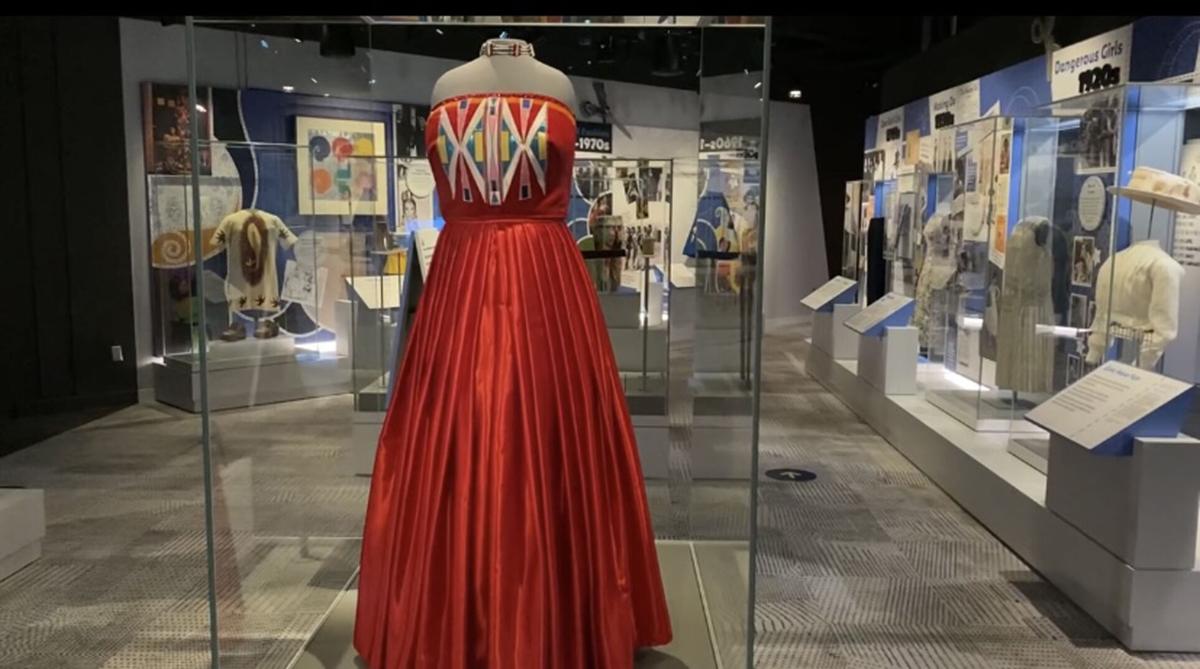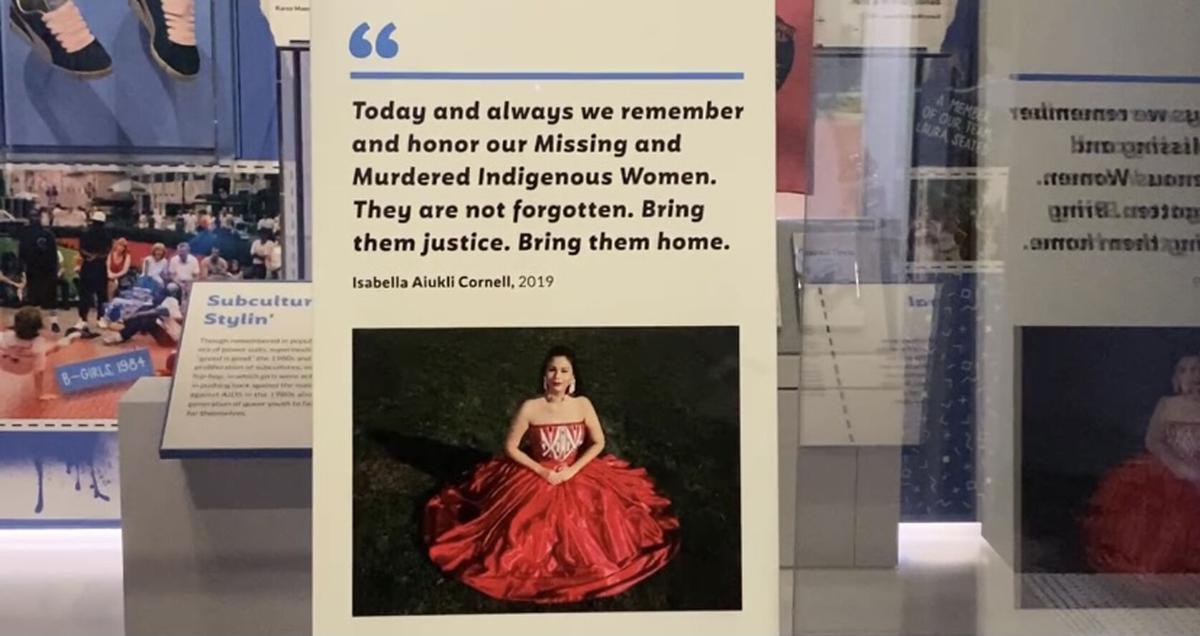
WASHINGTON — It’s one of the most important events in a teenager’s life, high school prom.
For Isabella Aiukli Cornell, her junior prom in 2018 was about more than just wearing a stylish gown to a high school gymnasium. It was an opportunity to call attention to what has been described as an epidemic of murder and abuse faced by Native American women.
“We have a really high rate of women who go missing every year and there’s not a lot of media coverage about it,” said Cornell. “I wanted to make a statement about the ongoing crisis going on in our communities.”
Government statistics are sobering. According to the Centers for Disease Control, Native women are murdered at a rate 10 times higher than other ethnicities. Figures of the National Institute of Justice suggests 84% of Native women have experienced violence in their lifetime.
The U.S. Department of Justice this week hired 11 specialized coordinators to help develop national standards to address the crisis.
For her prom in 2018, Cornell, of Oklahoma City and a member of the Choctaw Nation, chose a custom-made dress made by Crow designer Della Bighair-Stump of Hardin, Montana. The purpose was to bring attention to the peril faced by Indigenous women.
“The color red is symbolic of the Missing and Murdered Indigenous Women’s movement,” said Cornell. “The bodice was made to incorporate a little bit of the (Choctaw) tribe by adding diamonds to the design.”
Red is the official color of the Missing and Murdered Indigenous Women’s movement to symbolize a bold statement, indigenous women’s issues will be seen and heard.
Aside from being a statement color, multiple native tribes also believe that red is the only color that spirits can see. The project believes that the color not only will help to bring awareness to the cause but also help guide back the spirits of the murdered women and children so that they can lay them to rest.
The prom dress choice ended up making national headlines and was featured in magazines across the country.
The magazine Teen Vogue, in an article about Cornell’s dress, wrote: “Native dresses, like the ones designed by Della, are highlighting the unique way young Native people are incorporating their traditional heritage into contemporary spaces as a way to show off their ancestral pride.”
A year after the magazines were sold, Cornell and her mother were contacted by the Smithsonian National Museum of American History about including the gown in a new exhibit called, Girlhood.
“I am just super honored and very happy that my dress will be getting a lot of coverage,” said Cornell. “A lot of times the only people talking about MMIW are Native people.”
The Girlhood exhibit was created to commemorate the 100th anniversary of women’s suffrage by showcasing how women have changed history in five areas: politics, education, work, health and fashion.
Cornell’s dress sits in the center of the fashion section on display. From there, it will tour the country through the Smithsonian Institution Traveling Exhibition Service from 2023 through 2025.
“While I am a little bit sad that I don’t get to have it in my physical possession anymore, I’m more happy that a lot of other people will be able to learn something from it and for more awareness to be spread — because that’s the whole mission behind it.”
The student of Fort Lewis College, a former Indian boarding school turned public college, never expected to find her prom dress in the center of a Smithsonian museum exhibit but says that it gave her a chance to educate others on the struggles that Indigenous women face.
“By having it in the museum that means that a lot of other people will be able to see it and understand what’s going on and that's really just the whole goal behind all of this.”
Video and gallery: Tulsa World Magazine's 2020 Tulsans of the Year
Gallery: Tulsans of the Year: These people gave us hope
Tulsans of the Year: Aurash Zarkeshan

One hand squeeze for “yes,” two for “no.”
For those first few weeks in the hospital, it was about the only way Aurash Zarkeshan had of communicating.
“I had a breathing tube in, so I couldn’t talk. And one of my academy classmates who was visiting me came up with that idea,” he said.
Zarkeshan still doesn’t remember much from that dark time earlier this year. But there was one exchange, he said, that he was told about later.
Read the full story and Aurash Zarkeshan's first interview here.
Tulsans of the Year: Craig Johnson

All it took was one ride-along, and his mind was made up.
Craig Johnson, store manager for KB Toys, was going to change careers.
“He told me he was thinking about becoming a police officer,” said Susannah Ralston, officer with the Tulsa Police Department, adding that when asked if she’d take him out on a ride-along, she was happy to oblige.
“I think it was graveyard shift,” she said.
Read the full story about Sgt. Craig Johnson here.
Tulsans of the Year: Bruce Dart

The text message that popped up on his phone contained just a single word.
But for Dr. Bruce Dart, it communicated everything it needed to.
“I’ll never forget it — it was from our response incident commander and it just said ‘positive,’” he said.
Read the entire story about Dr. Bruce Dart here.
Tulsans of the Year: Health care workers

At the outset of the pandemic, health care workers were showered with gift baskets, parades, encouraging roadside signs and impressive F-16 fly-bys at hospitals.
However, those expressions of thanks have waned and the COVID-19 hospital admissions and virus-related deaths continue.
As Jake Henry Jr., president and CEO of Saint Francis Health System, noted, these frontline heroes “are exhausted after wearing personal protective equipment for a bustling 12-hour shift over and over again.
“When they get in their car and drive home, they are truly spent,” Henry said. “When they enter unmasked apathy in public places — stores, restaurants and public gatherings — they feel defeated.”
Read more about why we honored local health care workers as Tulsans of the Year.
Pictured above: Frontline workers James Burns, RN, BSN, Saint Francis Health System (left); Tulsa Fire Department Chief Michael Baker; Tulsa Health Department Division Chief of Prevention, Preparedness and Response Kelly VanBuskirk; Respiratory Therapist Brittany Ullrich from Ascension St. John Medical Center; Tulsa Health Department Executive Director Bruce Dart; Kayla Stack, EMSA medic and recipient of the 2020 Star of Life award; Dr. Guy Sneed, chief medical officer of Hillcrest HealthCare System; Nick Coffman, EMSA paramedic; Kelsey Two Bears, certified physician assistant at Sapulpa Indian Health Center of the Muscogee (Creek) Nation Department of Health, stand outside Tulsa Central Library.
Tulsan of the Year: G.T. Bynum

In a year that’s seen Tulsa face some of its most pressing challenges to date, Mayor G.T. Bynum has not shied away from the demands of leadership.
It started with a search he initiated to finally answer lingering questions about possible mass graves from the 1921 Tulsa Race Massacre.
The search, which is ongoing, has so far yielded an unmarked site containing 10 coffins. It remains to be determined if it’s massacre related, but it’s an important next step, the mayor said.
Then there’s Bynum’s part in Tulsa’s COVID-19 pandemic response.
Read the rest of G.T. Bynum's story here.
Tulsans of the year: Carlisha Williams Bradley

Carlisha Williams Bradley took on this challenging year with confidence and decisiveness.
In the pandemic’s early days, state leaders started deferring decisions to local levels. As a member of the state Board of Education, Bradley didn’t want to shirk that responsibility.
She was among the three board members pushing for strong statewide requirements, stating, “We are in the midst of something that is far worse than we ever predicted.”
Read the entire story about Carlisha Williams Bradley here.
MIKE SIMONS, Tulsa World Magazine
Tulsan of the Year: Keith Elder

It was an off-hand, almost joking comment that started the Tulsa Symphony Orchestra on the path to making history.
The orchestra, like almost every other performing arts group in the country, had been forced to postpone or cancel all of its concerts after the city of Tulsa shut down in March in the face of the burgeoning coronavirus pandemic
Most arts organizations resigned themselves to not performing at all or creating online, virtual content to keep their work before the public.
But the Tulsa Symphony, said Executive Director Keith C. Elder, was determined to get before a live audience again.
Read the full story about Keith Elder here.
Tulsan of the Year: Susan Ellerbach

After years of getting letters to the editor, this editor decided to write back.
Susan Ellerbach spent 35 years at the Tulsa World, working her way from a reporter to the top job in the newsroom. In 2014, she became the ninth executive editor since the first Tulsa World print edition published before statehood in 1905.
In her letter that was printed the week she retired in September, she reminded Tulsans of the importance of journalism in today’s world, not the talking heads that crowd cable channels. She told readers who relied on them to get their “news” that those aren’t actual broadcasts that report news.
“They are personalities who take news events and load them with opinion based on the interests and beliefs that sophisticated research tells them the audience would like to see,” she wrote. “Be aware of what news is and where you’re getting it.”
Read the entire story about Susan Ellerbach here.
Tulsans of the Year: Tykebrean Cheshier

Tykebrean Cheshier realized she was different at the age of 5 or 6.
Her grandparents hosted her birthday party, and she invited a little girl who lived across the street.
“Her father told her that she could not come to my birthday party because I was Black,” Cheshier said. “I heard him say it, but he used the N-word.”
Then, she ran crying to her grandmother, who tried to shield her from the racism she would experience.
Now 22, she’s facing it head-on.
Read the entire story about Tykebrean Cheshier here.
Tulsans of the Year: Lauren Landwerlin

Watching the epidemic spread across China, Saint Francis Hospital began stockpiling personal protective equipment in February, when the rest of Tulsa still seemed, if not oblivious, at least not terribly worried about COVID-19.
“I’m not saying we predicted the future,” says Lauren Landwerlin, executive director of corporate communications for the entire Saint Francis Health System. “But we saw the possibilities.”
The foresight allowed Saint Francis to ride out a disruption in the PPE supply chain until production ramped up in late spring. By June, as Black Lives Matter protests erupted across the area and President Donald Trump announced a campaign rally in Tulsa, Saint Francis was compiling data on how fast medical workers were going through mask supplies.
“We knew how many masks we were using per day,” Landwerlin says. “We knew how many masks we could have delivered and how long we could last if there was a shortage.”
Read the entire story about Lauren Landwerlin here.
Tulsans of the Year: Jeff Jaynes

The day third grade ended at Holland Hall, 8-year-old Jeff Jaynes went straight from school to the hospital.
He had gotten his tonsils taken out earlier that year. And after the simple operation, a nurse took a routine check of vital signs in the recovery room. She must have heard something unusual because she ordered a chest X-ray. And Jaynes went back later to have a grapefruit-sized tumor removed from tissue near his lungs.
If the nurse hadn’t been so diligent? If he hadn’t needed his tonsils removed?
“I wouldn’t still be here,” Jaynes said. “I was incredibly lucky.”
Read the entire story about Jeff Jaynes here.
Tulsans of the Year: Bryce Thompson

Being a McDonald’s All-American Game selection is usually a good predictor for a high school basketball player achieving college success and reaching the NBA.
In 2020, Bryce Thompson became only the fourth boys player from Tulsa in 43 years to receive that honor. The other three — Wayman Tisdale (1982), Lee Mayberry (1988) and Ryan Humphrey (1997) — all had stellar college careers and were NBA first-round draft choices.
“It was one of my goals growing up,” Thompson said about his selection. “Knowing my name is in the same category with some of the all-time greats to ever play the game is special. Definitely a blessing that I’m very thankful for.”
Read the entire story about Bryce Thompson here.
Ditch the feeling of disconnection by being in the know.

$5 for 5 months for a limited time or 52 weeks at just $39.99 for a digital subscription. Subscribe today.
Get local news delivered to your inbox!
December 12, 2020 at 01:08PM
https://ift.tt/37XyrjL
Native Oklahoma woman's prom dress now in Smithsonian exhibit - Tulsa World
https://ift.tt/2KksXom
Dress



No comments:
Post a Comment